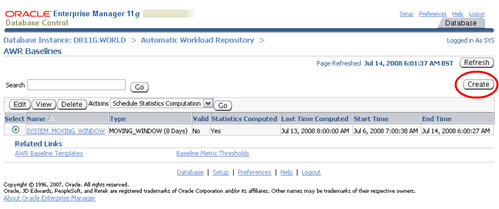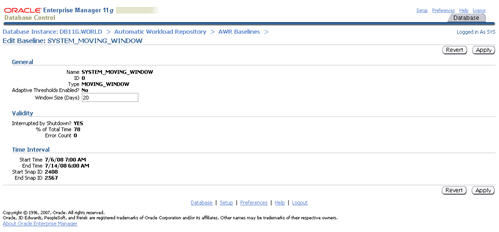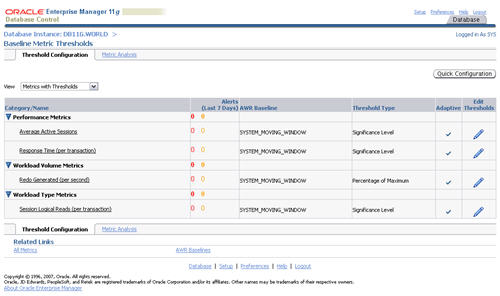分类: Oracle
2008-10-09 15:44:10
The Automatic Workload Repository (AWR) was introduced in Oracle 10g and included some simple baseline functionality. Creating a baseline allowed a specified range of snapshots to be retained, regardless of the AWR retention policy, and used for performance comparisons. This functionality, and the DBMS_WORKLOAD_REPOSITORY package that manages it, has been extended in Oracle 11g.
Note. Most of the procedures and functions in the DBMS_WORKLOAD_REPOSITORY package accept a DBID parameter, which defaults to the local database identifier. For that reason the following examples will omit this parameter.
Fixed Baselines
The Moving Window Baseline
Baseline Templates
Baseline Metric Thresholds
DBMS_WORKLOAD_REPOSITORY package included a single CREATE_BASELINE procedure allowing you to define baselines using specific snapshot IDs. It now includes overloaded procedures and functions allowing baselines to be created using start and end times, which are used to estimate the relevant snapshot IDs. The functions have the same parameter lists as the procedures, but return the baseline ID. By default baselines are kept forever, but the new expiration parameter allows them to be automatically expired after a specified number of days.SET SERVEROUTPUT ON
DECLARE
l_return NUMBER;
BEGIN
-- Using procedures.
DBMS_WORKLOAD_REPOSITORY.create_baseline(
start_snap_id => 2490,
end_snap_id => 2491,
baseline_name => 'test1_bl',
expiration => 60);
DBMS_WORKLOAD_REPOSITORY.create_baseline(
start_time => TO_DATE('09-JUL-2008 17:00', 'DD-MON-YYYY HH24:MI'),
end_time => TO_DATE('09-JUL-2008 18:00', 'DD-MON-YYYY HH24:MI'),
baseline_name => 'test2_bl',
expiration => NULL);
-- Using functions.
l_return := DBMS_WORKLOAD_REPOSITORY.create_baseline(
start_snap_id => 2492,
end_snap_id => 2493,
baseline_name => 'test3_bl',
expiration => 30);
DBMS_OUTPUT.put_line('Return: ' || l_return);
l_return := DBMS_WORKLOAD_REPOSITORY.create_baseline(
start_time => TO_DATE('09-JUL-2008 19:00', 'DD-MON-YYYY HH24:MI'),
end_time => TO_DATE('09-JUL-2008 20:00', 'DD-MON-YYYY HH24:MI'),
baseline_name => 'test4_bl',
expiration => NULL);
DBMS_OUTPUT.put_line('Return: ' || l_return);
END;
/
Return: 8
Return: 9
PL/SQL procedure successfully completed.
SQL>DBA_HIST_BASELINE view.COLUMN baseline_name FORMAT A15
SELECT baseline_id, baseline_name, START_SNAP_ID,
TO_CHAR(start_snap_time, 'DD-MON-YYYY HH24:MI') AS start_snap_time,
END_SNAP_ID,
TO_CHAR(end_snap_time, 'DD-MON-YYYY HH24:MI') AS end_snap_time
FROM dba_hist_baseline
WHERE baseline_type = 'STATIC'
ORDER BY baseline_id;
BASELINE_ID BASELINE_NAME START_SNAP_ID START_SNAP_TIME END_SNAP_ID END_SNAP_TIME
----------- --------------- ------------- ----------------- ----------- -----------------
6 test1_bl 2490 09-JUL-2008 17:00 2491 09-JUL-2008 18:00
7 test2_bl 2490 09-JUL-2008 17:00 2491 09-JUL-2008 18:00
8 test3_bl 2492 09-JUL-2008 19:00 2493 09-JUL-2008 20:00
9 test4_bl 2492 09-JUL-2008 19:00 2493 09-JUL-2008 20:00
4 rows selected.
SQL>BASELINE_ID with the SELECT_BASELINE_DETAILS pipelined table function, or the BASELINE_NAME with the SELECT_BASELINE_METRIC pipelined table function.SELECT *
FROM TABLE(DBMS_WORKLOAD_REPOSITORY.select_baseline_details(6));
SELECT *
FROM TABLE(DBMS_WORKLOAD_REPOSITORY.select_baseline_metric('SYSTEM_MOVING_WINDOW'));RENAME_BASELINE procedure.BEGIN
DBMS_WORKLOAD_REPOSITORY.rename_baseline(
old_baseline_name => 'test4_bl',
new_baseline_name => 'test5_bl');
END;
/DROP_BASELINE procedure.BEGIN DBMS_WORKLOAD_REPOSITORY.drop_baseline(baseline_name => 'test1_bl'); DBMS_WORKLOAD_REPOSITORY.drop_baseline(baseline_name => 'test2_bl'); DBMS_WORKLOAD_REPOSITORY.drop_baseline(baseline_name => 'test3_bl'); DBMS_WORKLOAD_REPOSITORY.drop_baseline(baseline_name => 'test5_bl'); END; /




RETENTION column of the DBA_HIST_WR_CONTROL view.SELECT retention FROM dba_hist_wr_control; RETENTION --------------------------------------------------------------------------- +00008 00:00:00.0 1 row selected. SQL>
MODIFY_SNAPSHOT_SETTINGS procedure, which accepts a RETENTION parameter in minutes.BEGIN
DBMS_WORKLOAD_REPOSITORY.modify_snapshot_settings(
retention => 43200); -- Minutes (= 30 Days).
END;
/
SELECT retention FROM dba_hist_wr_control;
RETENTION
---------------------------------------------------------------------------
+00030 00:00:00.0
1 row selected.
SQL>DBA_HIST_BASELINE view.SELECT moving_window_size
FROM dba_hist_baseline
WHERE baseline_type = 'MOVING_WINDOW';
MOVING_WINDOW_SIZE
------------------
8
1 row selected.
SQL>MODIFY_BASELINE_WINDOW_SIZE procedure, which accepts a WINDOW_SIZE parameter in days.BEGIN
DBMS_WORKLOAD_REPOSITORY.modify_baseline_window_size(
window_size => 20);
END;
/
SELECT moving_window_size
FROM dba_hist_baseline
WHERE baseline_type = 'MOVING_WINDOW';
MOVING_WINDOW_SIZE
------------------
20
1 row selected.
SQL>



CREATE_BASELINE_TEMPLATE procedure define the capture of individual baselines, or repeating baselines. Creating a single baseline template is similar to creating a time-based baseline, except the time is in the future.BEGIN
DBMS_WORKLOAD_REPOSITORY.create_baseline_template(
start_time => TO_DATE('01-DEC-2008 00:00', 'DD-MON-YYYY HH24:MI'),
end_time => TO_DATE('01-DEC-2008 05:00', 'DD-MON-YYYY HH24:MI'),
baseline_name => '01_dec_008_00_05_bl',
template_name => '01_dec_008_00_05_tp',
expiration => 100);
END;
/START_TIME and END_TIME parameters define when the template is activated and deactivated. The DAY_OF_WEEK, HOUR_IN_DAY and DURATION parameters define the day (MONDAY - SUNDAY or ALL) the baselines are generated on and the start and end point of the baseline. Since the template will generate multiple baselines, the baseline name is derived from the BASELINE_NAME_PREFIX concatenated to the date. The following example creates a template that will run for the next six months, gathering a baseline every Monday between 00:00 and 05:00.BEGIN DBMS_WORKLOAD_REPOSITORY.create_baseline_template( day_of_week => 'MONDAY', hour_in_day => 0, duration => 5, start_time => SYSDATE, end_time => ADD_MONTHS(SYSDATE, 6), baseline_name_prefix => 'monday_morning_bl_', template_name => 'monday_morning_tp', expiration => NULL); END; /
DBA_HIST_BASELINE_TEMPLATE view.SELECT template_name,
template_type,
baseline_name_prefix,
start_time,
end_time,
day_of_week,
hour_in_day,
duration,
expiration
FROM dba_hist_baseline_template;
TEMPLATE_NAME TEMPLATE_ BASELINE_NAME_PREFIX START_TIME
------------------------------ --------- ------------------------------ --------------------
END_TIME DAY_OF_WE HOUR_IN_DAY DURATION EXPIRATION
-------------------- --------- ----------- ---------- ----------
01_dec_008_00_05_tp SINGLE 01_dec_008_00_05_bl 01-DEC-2008 00:00:00
01-DEC-2008 05:00:00 100
monday_morning_tp REPEATING monday_morning_bl_ 11-JUL-2008 14:43:36
11-JAN-2009 14:43:36 MONDAY 0 5
2 rows selected.
SQL>BASELINE_NAME_PREFIX column holds either the prefix or full baseline name depending on the type of baseline being captured.DROP_BASELINE_TEMPLATE procedure.BEGIN DBMS_WORKLOAD_REPOSITORY.drop_baseline_template (template_name => '01_dec_008_00_05_tp'); DBMS_WORKLOAD_REPOSITORY.drop_baseline_template (template_name => 'monday_morning_tp'); END; /











